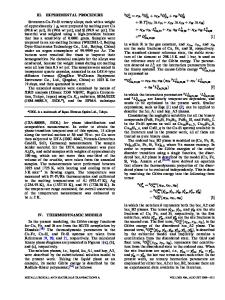Thermodynamic Re-Assessment of the Co-Nb System
- PDF / 719,839 Bytes
- 6 Pages / 595 x 842 pts (A4) Page_size
- 49 Downloads / 388 Views
1128-U05-30
Thermodynamic Re-Assessment of the Co-Nb System C. He, F. Stein, M. Palm and D. Raabe Max-Planck-Institut für Eisenforschung GmbH, Postfach 140444, D-40074 Düsseldorf, Germany
ABSTRACT A new thermodynamic assessment of the Co-Nb system is presented. All experimental phase diagram data available from the literature have been critically reviewed and assessed using thermodynamic models for the Gibbs energies of the individual phases (Thermo-Calc). Compared to previous assessments more elaborate models for the description of the C14 and C36 Laves phases and for the µ phase were employed. Thereby a calculated phase diagram is obtained which satisfactorily agrees with the experimental data.
INTRODUCTION The Laves phases AB2 form the largest group of intermetallic compounds. Three different crystallographic polymorphs exist, namely cubic MgCu2-type (C15) and hexagonal MgZn2-type (C14) and MgNi2-type (C36). Since the last decade, there is renewed interest in Laves phases as they have become candidates for several functional applications such as hydrogen storage as well as structural materials [1, 2]. Though, development of such materials is considerably hindered by the fact that the stability of the Laves phases in certain systems, the occurrence of the various polymorphs in dependence of composition and temperature, and the transformation from one polymorph into another are up to now not well understood [3,4]. The Co-Nb system is an excellent candidate for fundamental studies of the stability of Laves phases because all three polymorphs occur within this system. Moreover, Co and Nb are also two important alloying elements for high-temperature superalloys, which make this system of considerable interest. Therefore, phase equilibria in the Co–Nb system have been studied experimentally quite frequently before [5-13], but reported data show noticeable discrepancies. In order to settle these uncertainties and specifically the stability of the different Laves phase polymorphs, the system has been recently reinvestigated [14]. Based on the earlier literature data, several thermodynamic assessments of the Co-Nb system have been performed [15-18] and the latest and most comprehensive work was carried out by Hari Kumar et al. [18]. They considered the five binary compounds C14, C15, C36, Co7Nb2, and µ phase in their calculation. However, the homogeneity ranges of the C14 and C36 Laves phases were not considered and both phases were simply modeled as stoichiometric compounds (Co16Nb9 and Co3Nb, respectively) due to the lack of respective data at that time. The purpose of the present work is to obtain a self-consistent set of thermodynamic parameters of the Co-Nb system by considering the latest experimental work with specific emphasis on modeling the homogeneity ranges for the Laves phases.
EXPERIMENTAL DATA The literature data up to 1997 were critically reviewed by Hari Kumar et al. [18]. At that time the existence of the µ phase and C15 were accepted, but the existence of C36, C14 and Co7Nb2 was debatable. Recently
Data Loading...











